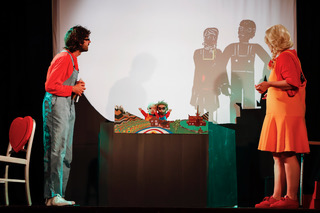Review: Nordic Noir at Australian Hall
- Theatre Travels

- Mar 28, 2021
- 4 min read
Review by Lily Stokes
First published in 1876, Peer Gynt is a canonical five-act play by Norwegian playwright Henrik Ibsen. Based on a Norwegian fairytale of the same name, it chronicles the turbulent travels of Peer Gynt as he journeys across the sea from the Norwegian mountains to the North African desert. After a lifetime of avoidance, procrastination and selfishness, Peer returns to his hometown only to be confronted by “all that he had not done” on his deathbed. With incidental music by Edvard Grieg, this play features several iconic musical themes (such as ‘In the Hall of the Mountain King’ and ‘Morning Music’) that continue to thrill audiences today.
Endangered Productions’ Nordic Noir was born from a cancelled production of Ibsen’s play, which became victim to COVID-19 in the midst of the pandemic. However, if there were any silver lining to its cancellation, it was that a fascinating piece of theatre by Fredrik Brattberg has now been staged in harmony with music from Peer Gynt.
Separated into two defined acts, Nordic Noir features six of the most stirring pieces from Grieg’s suite in the first act (accompanied by a stylistically-faultless string quartet, led by music director Peter Alexander) and a performance of Fredrik Brattberg’s Virus - A Fugue as the second act. The two acts are underpinned by the concept of fugue, described by Brattberg as “a polyphonic piece of music where each voice starts by playing the same melody”. Doubling as a comment on COVID-19, the play’s repetitive structure was reflective of how the pandemic has created “a dramaturgical formula that produce[s] fugue-like stories”. Most engagingly, this “multi-layered trai-comic polemic of now“ (Karen Lambert) transformed musical concepts from Peer Gynt into a poignant comment on COVID-19, allowing audiences to “see [their] times” reflected in the enduring work of Ibsen and Greig.
Nordic Noir’s first act featured a range of outstanding performances, including a captivating narration by Marty O’Neill. Opening with the iconic ‘In the Hall of the Mountain King’, guest dancer Isaac Clark brought Ruth Bent’s choreography to life. An encapsulation of the repetitive fugual form, this performance was reminiscent of Belgian choreographer Anne Teresa De Keersmaeker’s Rosas danst Rosas (famously plagirised by Beyonce in her Countdown music video) which makes a similar comment on repetitive movement.
Arbanian Dance was perfectly self-aware, playing on tropes of exoticism and integrating eccentric props (Karen Lambert) and lighting design (Michael Schell). This provided a considered contrast with Morning Music, in which Wiradjuri Woman Rayma Johnson encapsulated the Spirit of the Morning, preparing “a ritual she has done each new morning since time began”. This was an especially moving performance, considering the historical venue (Australia Hall) is owned by the Metropolitan Local Aboriginal Land Council. Peer Gynt’s Serenade provided another shade, with the darks and lights of the six pieces propelling the first act and keeping the audience engaged. Solveig’s Song featured the effortless vocals of Lesley Braithwaite, performing the iconic octave jump with ease. Peer Gynt and the Herd Girls highlighted Karen Lambert’s playful design, with extravagant puppets and costumes on show (I loved the beautiful undercoat of flowers hoisted up by Natalie Rose Cassaniti in the number). Under seasoned music direction (Peter Alexander), the string quartet were skillful and stylistic - my only critique is that the pit singing (“hear him”) could have been more forceful to match the dialogue. Ultimately, the first act of Nordic Noir put an absurdist-edge on a delightful rendition of Ibsen and Greig’s enduring work, which provided a great introduction to the second act; Brattberg’s Virus - A Fugue.
Virus - A Fugue opened with a performance of Johann Sebastian Bach’s ‘Little’ Fugue in G Minor, accompanied by a sonic visualisation of the piece. The video clarified the concept of fugue, making the structure of the subsequent play accessible to less-musical audiences. I want to acknowledge the work of the string quartet in keeping Bach’s fugue time with the video, which would have been no easy task.
Brattberg’s Virus - A Fugue plays on the classic ‘play within a play’ trope, popular in Elizabethan times and seen extensively in Shakespeare. Instead, ‘He’ (Andrew Lindqvist) and ‘She’ (Lesley Braithwaite) construct a “model village inside a model village”, with each layer depicted by a different form of puppetry. As ‘She’ begins to feel ill, the couple lament over which model village (or ‘layer’) contains the virus, using chlorine spray and isolating walls to try and prevent cross-contamination between realities.
Overall, the dynamic between ‘He’ and ‘She’ was the focal point of the piece, and could have been developed to reflect the play’s absurdist and comedic predecessors (think Estragon and Vladimir from Waiting for Godot, or Moon and Birdfoot from The Real Inspector Hound). The dialogue at times was slow and lacked ‘imagination’, so stronger direction and a few speed runs could have helped encourage more engaging delivery. The use of space was fantastic, and the puppetry was thrilling - shout out to the puppeteers, puppet makers and puppet videographer (Wayne Richmond) for making it all come together. Brattberg’s “fugue for theatre” was thought provoking, and integrated perfectly with Peer Gynt (as Brattberg details, “in music, it’s impossible to separate form and content”). Overall, Virus - A Fugue somehow made fugue as relevant to 2021 audiences as it would have been to Ibsen and Greig.
I could only describe Nordic Noir as a fever dream of puppetry, music, song and dance. I truly felt like I’d been sent through the looking-glass, only to be confronted by the absurdity of the COVID-19 pandemic. However, if Endangered Production’s Nordic Noir aimed to create an “inclusive, creative world of theatre” (words of director Christine Logan), I think it succeeded by making Peer Gynt and fugue accessible and enjoyable.
Image Credit: Nordic Noir Team



























